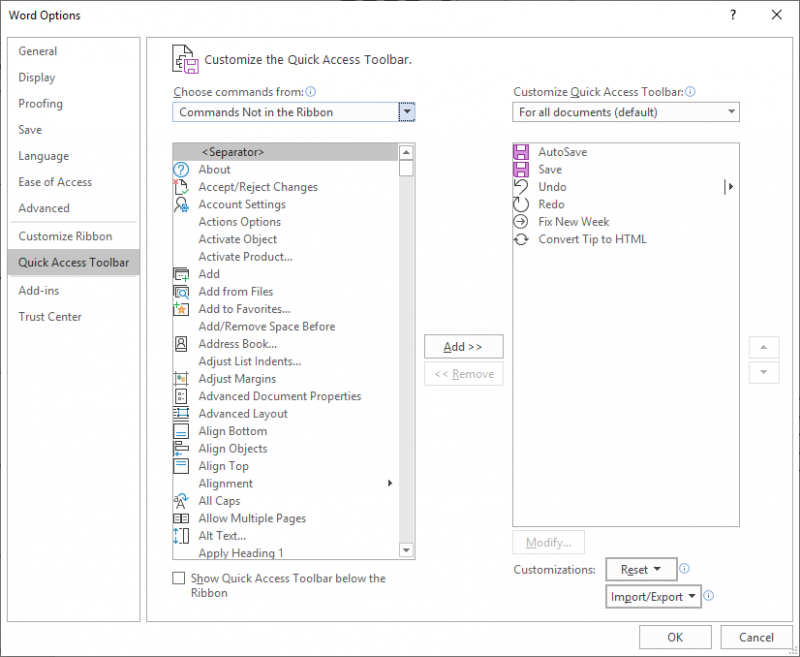Written by Allen Wyatt (last updated August 2, 2023)
This tip applies to Word 2007, 2010, 2013, 2016, 2019, and 2021
An AutoMark file, also called a concordance file, can be used by Word to automatically mark a document for an index. You create the file, which specifies what words or phrases you want marked for the index, and then Word searches through the document, looking for those words and phrases and marking them accordingly. You can use the file to not only specify main index entries, but also subentries.
If you want to use an AutoMark file with your document, you must first customize Word's Quick Access toolbar. Follow these steps:

Figure 1. The Quick Access Toolbar options of the Word Options dialog box.
Now, if you click on the Index and Options dot, you will see the Index and Options dialog box and you can click the AutoMark button within that dialog box.
Basically, an AutoMark file consists of a two-column table. In the left-hand column you specify the word or phrase that you want to trigger an index entry. In the right-hand column you specify the actual index entry itself. For instance, in the left-hand column you might enter Menkaure, and in the right column you might enter Pyramids. In this way, every occurrence of the word Menkaure in your document would result in an index entry under the word Pyramids.
If you want to get more specific, you could specify that a particular keyword should go under a subentry. For instance, you could put the word Menkaure in the left-hand column, and in the right you could put Pyramids:Egypt. In this way, every instance of the Menkaure in your document would result in an index entry under the word Egypt, which is a sub-entry to the word Pyramids. Likewise, you could put Teotihuachuan is marked as an index entry under Mexico, which is under Pyramids.
WordTips is your source for cost-effective Microsoft Word training. (Microsoft Word is the most popular word processing software in the world.) This tip (5985) applies to Microsoft Word 2007, 2010, 2013, 2016, 2019, and 2021.

Do More in Less Time! An easy-to-understand guide to the more advanced features available in the Microsoft 365 version of Word. Enhance the quality of your documents and boost productivity in any field with this in-depth resource. Complete your Word-related tasks more efficiently as you unlock lesser-known tools and learn to quickly access the features you need. Check out Microsoft 365 Word For Professionals For Dummies today!
Adding an index to a document can be a nice finishing touch, particularly if the document is a long one. What happens if ...
Discover MoreAfter you get your document ready for indexing by inserting index fields throughout it, you may want to index only a ...
Discover MoreWhen generating an index, Word normally uses a dash to indicate page ranges. You can change the character used for these ...
Discover MoreFREE SERVICE: Get tips like this every week in WordTips, a free productivity newsletter. Enter your address and click "Subscribe."
2023-12-19 17:13:13
D
You may want to mention that after selecting the AutoMark file in the index dialog, the dialog disappears but no index is created. You need to add an index by invoking the index dialog again and adding an index without specifying the AutoMark file.
2020-08-24 11:47:11
Gregg
Why must I add Automark to the ribbon bar? Isn't it just a keyboard shortcut away?
And what does the color of the dot mean? Where is the full definition of what I can put in the concordance table?
Got a version of Word that uses the ribbon interface (Word 2007 or later)? This site is for you! If you use an earlier version of Word, visit our WordTips site focusing on the menu interface.
Visit the WordTips channel on YouTube
FREE SERVICE: Get tips like this every week in WordTips, a free productivity newsletter. Enter your address and click "Subscribe."
Copyright © 2025 Sharon Parq Associates, Inc.
Comments